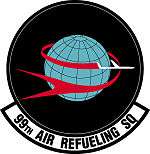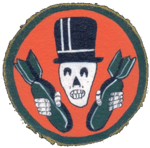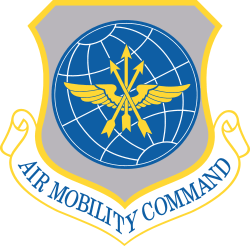99th Air Refueling Squadron
The 99th Air Refueling Squadron is part of the 6th Air Mobility Wing at MacDill Air Force Base, Florida, but is stationed at Birmingham Air National Guard Base, Alabama. It is an Active Associate Unit, an active duty component attached to the Alabama Air National Guard's 117th Air Refueling Wing. The 99th Air Refueling Squadron works with, supports and flies the 117th Air Refueling Wing's Boeing KC-135R Stratotanker aircraft.
| 99th Air Refueling Squadron | |
|---|---|
 117th Air Refueling Wing KC-135s on the Birmingham ANGB flightline | |
| Active | 1942–1944; 1957–1973; 1983–2008; 2009–present |
| Country | |
| Branch | |
| Role | Air Refueling |
| Part of | Air Mobility Command |
| Garrison/HQ | Birmingham Air National Guard Base |
| Nickname(s) | Ramrod (While Stationed at Westover 1957-1973) |
| Engagements | Kosovo Southwest Asia[1] |
| Decorations | Air Force Outstanding Unit Award with Combat "V" Device Meritorious Unit Award Air Force Outstanding Unit Award Republic of Vietnam Gallantry Cross with Palm[1] |
| Insignia | |
| 99th Air Refueling Squadron emblem (approved 15 May 1959)[1] (restored) |  |
| 99th Air Refueling Squadron emblem (approved March 1984)[2] | .png) |
| 399th Bombardment Squadron emblem (approved 25 February 1943)[3] |  |
The first predecessor of the squadron was organized during World War II as the 9th Reconnaissance Squadron. Redesignated the 399th Bombardment Squadron, it served as a crew training unit until inactivated in May 1944.
The 99th Air Refueling Squadron was activated in July 1957 and served with Strategic Air Command (SAC) until 1973, and again from 1983. In 1985, it was consolidated with the 399th Bombardment Squadron. When SAC was inactivated in 1992, the squadron became an element of Air Mobility Command. The squadron was inactivated in 2008, but was reactivated as an associated unit the following year.
History
World War II
The earliest predecessor of the squadron was constituted in January 1942 as the 9th Reconnaissance Squadron. However, the squadron was redesignated as the 399th Bombardment Squadron before activating on paper at Salt Lake City Army Air Base, Utah as one of the original four squadrons of the 88th Bombardment Group.[3][4]
In September the squadron moved to Geiger Field, Washington, then to Walla Walla Army Air Base, Washington and received its first personnel and Boeing B-17 Flying Fortresses and became a heavy bomber Operational Training Unit (OTU) under II Bomber Command.[4] The OTU program involved the use of an oversized parent unit to provide cadres to "satellite groups."[5] The squadron's time as an OTU was brief and it soon became a Replacement Training Unit (RTU).[4] Like OTUs, RTUs were also oversized units, but their mission was to train individual pilots or aircrews.[5]
In November 1943 the squadron moved to Avon Park Army Air Field, Florida[1] and became part of III Bomber Command,[4] as Second Air Force concentrated on training Boeing B-29 Superfortress aircrews. However, the Army Air Forces found that standard military units, based on relatively inflexible tables of organization, were not proving well adapted to the training mission. Accordingly, it adopted a more functional system in which each base was organized into a separate numbered unit,[6] while the groups and squadrons like the 399th acting as RTUs were disbanded or inactivated in the spring of 1944.[3][7]
Strategic Air Command air refueling
The 99th Air Refueling Squadron was activated at Turner Air Force Base, Georgia in July 1957 as a Boeing KC-135 Stratotanker squadron under Strategic Air Command (SAC) and assigned to the 4050th Air Refueling Wing. The following month it moved to Westover Air Force Base, Massachusetts, where wing headquarters was located. Beginning in 1958, The 99th conducted theater and overseas air refueling.[1] In 1963, the 4050th Wing, which was a Major Command controlled wing and could not continue its history if discontinued, was replaced by the 499th Air Refueling Wing, an Air Force controlled wing, which could continue its history through periods of inactive service. In December 1965, operational control of the squadron was transferred to the 99th Bombardment Wing, which became the parent of the squadron when the 499th Wing was inactivated in January 1966.[8][9]
Starting in 1965 the 99th supported operations in Southeast Asia. For its efforts, it earned the Air Force Outstanding Unit Award with Combat "V" Device and the Republic of Vietnam Gallantry Cross with Palm. During several periods after 1967, all squadron resources were transferred to units supporting the Vietnam war, although the squadron nominally remained at Westover.[8] The squadron was inactivated in September 1973 as the 99th Wing reduced its operations in preparing Westover for transfer to the Air Force Reserve.[1][9][10]
Airborne command post operations
In 1962, SAC established an airborne command post at Offutt Air Force Base, Nebraska, nicknamed Looking Glass, to ensure continuity of command and control of SAC forces in the event of a nuclear attack. Looking Glass was soon augmented by auxiliary aircraft stationed with the headquarters of SAC's three Numbered Air Forces. The 99th Squadron added Boeing EC-135 aircraft to its inventory in 1965 to operate the Eastern Auxiliary Command Post for Eighth Air Force at Westover. The EC-135s had turbofan engines, were equipped with advanced electronics equipment, and could be refueled by other tankers while retaining the refueling capability of the KC-135s. The 99th continued to operate EC-135s until 1 April 1970, when SAC reorganized its airborne command post aircraft and withdrew them from vulnerable bases near the coasts like Westover and assigned them to the 2d, 3d, and 4th Airborne Command and Control Squadrons, stationed at bases closer to the heartland of North America.[11]
Reactivation at Robins Air Force Base
In October 1983 the squadron was reactivated at Robins Air Force Base, Georgia,[1] becoming the second refueling squadron of the 19th Air Refueling Wing when the 19th Wing converted from the strategic bombardment mission and lost its Boeing B-52 Stratofortress aircraft.[12] It again flew worldwide aerial refueling missions. Between 1984 and 1991 it also performed the airborne command post mission.[1]
Shortly after its activation, the 99th supported Operation Urgent Fury, which replaced the Stalinist regime in Grenada. In December 1989, 99th tankers supported Operation Just Cause, which ousted Manuel Noriega as the leader of Panama. In its last contingency operation while part of SAC, the unit deployed aircraft and crew to support Operation Desert Shield in August 1990 and continued its deployment through Operation Desert Storm, which ended the occupation of Kuwait by Iraq.[1]
Air Mobility Command
In 1992, the Air Force reorganized its combat forces. In the reorganization, tanker aircraft, which had been assigned to SAC, were mostly reassigned to the new Air Mobility Command (AMC). Under AMC, the squadron participated in Operation Deny Flight over Bosnia, from January to February 1995 and again in August 1996. It provided personnel and aircraft to refuel aircraft participating in Operations Provide Comfort, Northern Watch and Southern Watch, enforcing no-fly zones over Iraq in 1996. Deployed squadron operations along the border of Iraq continued in the following two years in Operations Phoenix Scorpion, Desert Thunder and Desert Fox.[1]
In 1998 and 1999 the squadron supported Operations Noble Anvil, Deliberate Forge and Allied Force over the Balkans in areas that had been part of Yugoslavia.[1]
Closer to home, The squadron also refueled aircraft involved in Operation Constant Vigil, counter drug operations over the Caribbean Sea in 1998. These operations later expanded to locations in South America. After the terrorist attacks on New York City and the Pentagon on 11 September 2001, the squadron supported Operation Enduring Freedom in Afghanistan and Operation Iraqi Freedom in Iraq. The unit also transported Taliban and Al Qaeda detainees to the Guantanamo Bay detention camp, Cuba. In 2008, the squadron was inactivated at Robins.[1]
Active Associate unit
In October 2009, the 99th was reactivated at Birmingham Air National Guard Base, Alabama as part of the Air Force's "Total Force Integration" initiative. The squadron and its personnel remain an active duty Air Force unit with administrative control falling to the 6th Operations Group at MacDill Air Force Base, Florida.[1] Operational direction for day-to-day taskings comes from the 117th Air Refueling Wing of the Alabama Air National Guard at Birmingham as the squadron's personnel operate the KC-135s of the 117th's 106th Air Refueling Squadron.[13]
Lineage
399th Bombardment Squadron
- Constituted as the 9th Reconnaissance Squadron (Heavy) on 28 January 1942
- Redesignated 399th Bombardment Squadron (Heavy) on 22 Apr 1942
- Activated on 15 July 1942
- Inactivated on 1 May 1944
- Consolidated with the 99th Air Refueling Squadron as the 99th Air Refueling Squadron on 19 September 1985[1]
99th Air Refueling Squadron
- Constituted as the 99th Air Refueling Squadron, Heavy on 12 February 1957
- Activated on 1 July 1957
- Inactivated on 30 September 1973
- Activated on 1 October 1983
- Consolidated with the 399th Bombardment Squadron on 19 September 1985
- Redesignated 99th Air Refueling Squadron on 1 September 1991
- Inactivated on 1 September 2008
- Activated on 1 October 2009[1]
Assignments
- 88th Bombardment Group, 15 July 1942 – 1 May 1944
- 4050th Air Refueling Wing, 1 July 1957
- 499th Air Refueling Wing, 1 January 1963
- 99th Bombardment Wing, 1 January 1966 – 30 September 1973
- 19th Air Refueling Wing, 1 October 1983
- 19th Operations Group (later 19th Air Refueling Group), 1 September 1991 – 1 September 2008
- 6th Operations Group, 1 October 2009 – present[1] (attached to 117th Operations Group)
Stations
|
|
Aircraft
- Boeing B-17 Flying Fortress (1942–1944)
- Boeing KC-135 Stratotanker (1957–1973, 1983–present)
- Boeing EC-135 (1965–1970, 1984–1997)
- Boeing EC-137 Stratoliner (1991–1994)[1]
References
- Notes
- Robertson, Patsy (22 October 2009). "Factsheet 99 Air Refueling Squadron (AMC)". Air Force Historical Research Agency. Retrieved 17 April 2017.
- Approved insignia for: 99th Air Refueling Squadron (15 March 1984) National Archives
- Maurer, Combat Squadrons, pp. 489-490
- Maurer, Combat Units p. 154
- Craven & Cate, Introduction, p. xxxvi
- Goss, p. 75
- Maurer, Combat Units, p. 7
- Ravenstein, p. 272
- Ravenstein, pp. 141-142
- Mueller, p. 578
- Ogletree, Greg. "A History of the Post Attack Command and Control System (PACCS)". Strategic Air Command Airborne Command and Control Association. Archived from the original on 10 September 2012. Retrieved 14 May 2014.
- Robertson, Patsy (7 November 2008). "Factsheet 19 Airlift Wing (AMC)". Air Force Historical Research Agency. Retrieved 18 April 2017.
- "117th Air Refueling Wing: Units". 117th Air Refueling Wing Public Affairs. Retrieved 17 April 2017.
Bibliography
![]()
- Craven, Wesley F.; Cate, James L., eds. (1955). The Army Air Forces in World War II (PDF). Vol. VI, Men & Planes. Chicago, Illinois: University of Chicago Press. LCCN 48003657. OCLC 704158. Retrieved 17 December 2016.
- Goss, William A. (1955). "The Organization and its Responsibilities, Chapter 2 The AAF". In Craven, Wesley F.; Cate, James L. (eds.). The Army Air Forces in World War II (PDF). Vol. VI, Men & Planes. Chicago, Illinois: University of Chicago Press. LCCN 48003657. OCLC 704158. Retrieved 17 December 2016.
- Maurer, Maurer, ed. (1983) [1961]. Air Force Combat Units of World War II (PDF) (reprint ed.). Washington, DC: Office of Air Force History. ISBN 0-912799-02-1. LCCN 61060979. Retrieved 17 December 2016.
- Maurer, Maurer, ed. (1982) [1969]. Combat Squadrons of the Air Force, World War II (PDF) (reprint ed.). Washington, DC: Office of Air Force History. ISBN 0-405-12194-6. LCCN 70605402. OCLC 72556. Retrieved 17 December 2016.
- Mueller, Robert (1989). Air Force Bases, Vol. I, Active Air Force Bases Within the United States of America on 17 September 1982 (PDF). Washington, DC: Office of Air Force History. ISBN 0-912799-53-6. Retrieved 17 December 2016.
- Ravenstein, Charles A. (1984). Air Force Combat Wings, Lineage & Honors Histories 1947-1977. Washington, DC: Office of Air Force History. ISBN 0-912799-12-9. Retrieved 17 December 2016.

